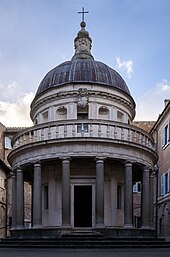
Back Renaissance-argitektuur Afrikaans Architektur der Renaissance ALS عمارة عصر النهضة Arabic Arquiteutura del Renacimientu AST İntibah memarlığı Azerbaijani Архітэктура Адраджэння Byelorussian Ренесансова архитектура Bulgarian রেনেসাঁ স্থাপত্য Bengali/Bangla Arquitectura del Renaixement Catalan Renesanční architektura Czech



Renaissance architecture is the European architecture of the period between the early 15th and early 16th centuries in different regions, demonstrating a conscious revival and development of certain elements of ancient Greek and Roman thought and material culture. Stylistically, Renaissance architecture followed Gothic architecture and was succeeded by Baroque architecture and neoclassical architecture. Developed first in Florence, with Filippo Brunelleschi as one of its innovators, the Renaissance style quickly spread to other Italian cities. The style was carried to other parts of Europe at different dates and with varying degrees of impact.
Renaissance style places emphasis on symmetry, proportion, geometry and the regularity of parts, as demonstrated in the architecture of classical antiquity and in particular ancient Roman architecture, of which many examples remained. Orderly arrangements of columns, pilasters and lintels, as well as the use of semicircular arches, hemispherical domes, niches and aediculae replaced the more complex proportional systems and irregular profiles of medieval buildings.
- ^ a b Grundmann, Stefan, ed. (1998). "High Renaissance and Mannerism – Tempietto". The Architecture of Rome: An Architectural History in 400 Individual Presentations (2nd Revised ed.). Stuttgart and London: Edition Axel Menges. pp. 123–125. ISBN 978-3-936681-16-1. Archived from the original on 22 November 2022. Retrieved 22 November 2022.
- ^ Falconi, Fabrizio (2015). Roma segreta e misteriosa (in Italian). Newton Compton Editori. ISBN 9788854188075. Retrieved 19 August 2019.